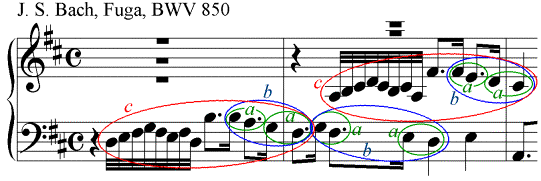![]()
Terms of the Music Theory with Audio Samples
| Home | Index | Literature | Documents | Contact |
A sequence of tones that appears repeatedly in a piece of music in the same or modified form. The modification usually consists in the fact that the tone sequence has its starting point at different scale degrees. However, it can also occur as an inversion; or the tone sequence can be varied according to other easily visible criteria. A motif can be repeated in the same voice, for example as a sequence, or in another voice. In the latter case, one speaks of an imitation.
The characteristic of being a motif exists only retroactively for a tone sequence: as a result of the reappearance of this tone sequence in the same or varied form. The motif is thus a typical reflex category in which the similarity is reflected in the phases of the voice movement.
Since within a piece of music very specific tone sequences always function as motifs, and motifs are identified in practice by their melodic peculiarity, the illusion easily arises that this determination is inherent to the tone sequence as such, that a tone sequence can be a motif per se. This led to the development of false theories about the motif, in which it was claimed that the motif was a "smallest unit" and as such a "germ", which by itself caused the reappearance of a sequence of tones. This twist of cause and effect belongs to the standard of popular music encyclopaedias and music teachings.
|
|
|
|
|
When a motif is reversed, all intervals of a sequence are executed in the opposite direction. An example of this is the part of the first oboe in the following Bourrée:
J. S. Bach, Orchestral Suite No. 4 (BWV 1069), Bourrée II

In the first line, one can see the initial shape of the motif, in the second line the inversion. Both forms appear at the same time as a sequence.
|
|
|
|
|
Sequence, Imitation, Subject, Theme
A sequence is the repetition of a motif on another scale degree and in immediate succession. In the example below, motif b appears in a sequence in the lower voice. It, in turn, contains a sequence in itself, i.e. it is a composite motif. The motif a is part of the motif b. Since the tone sequence b also appears in the upper voice, it is also a motif there; but only because it was previously also heard in the lower voice. The sequence is one of the simplest forms in which the motif appears. It is already very common in children's songs, but also in pop music.
An imitation is the replication of a melodic section in another voice. An imitation is also a manifestation of the motif. In the example below, the imitated motif c is a fugue subject.
A subject or theme is a motif that predominates in a piece of music and thus impresses its melodic characteristics on it.

|
|
|
|
|
Stretto is an imitation that begins at a point in time when the imitated motif has not yet been played to its end in another voice.
J. S. Bach, Inventio 8, BWV 779

In this example, the piece begins with a stretto. While the motif b in the upper voice has been only half played, the lower voice in the second bar begins with the imitation of the upper voice. In the third bar, the imitation is extended to the melodic sequence of the upper voice in the second bar. The pattern of the imitation is not yet finished when the copying process is beginning. Where the motive b ends becomes apparent in the fourth bar: There, the melodic course of the lower voice separates from the model of the upper voice. The fact that the identity of a motif only reveals itself afterwards lies in the nature of the motif
In addition to the stretto, the example shows another manifestation of the motif: the sequence, in which the motif a is constituted.
|
|
|
|
|
|
© 2020 Franz Sauter, Hamburg |